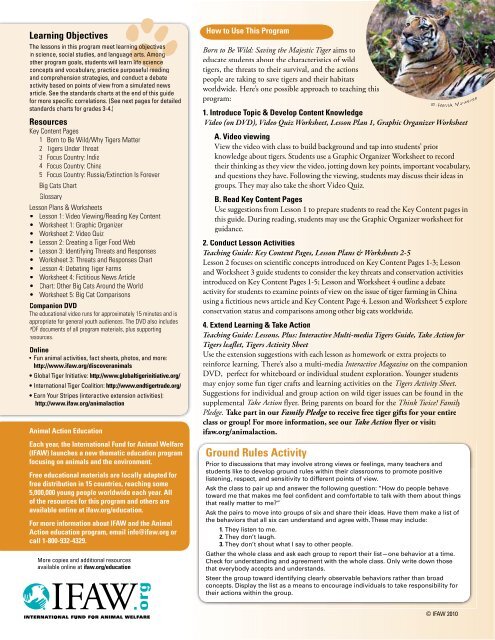Born to Be Wild - International Fund for Animal Welfare
Born to Be Wild - International Fund for Animal Welfare
Born to Be Wild - International Fund for Animal Welfare
Create successful ePaper yourself
Turn your PDF publications into a flip-book with our unique Google optimized e-Paper software.
Learning Objectives<br />
The lessons in this program meet learning ng objectiv objectives s<br />
in science, social studies, and language e arts. Among<br />
other program goals, students will learn life science<br />
concepts and vocabulary, practice purposeful read reading<br />
and comprehension strategies, and conduct a debate<br />
activity based on points of view from a simulated news<br />
article. See the standards charts at the end of this guide<br />
�����������������������������������������������������������<br />
standards charts <strong>for</strong> grades 3-4.)<br />
Resources<br />
Key Content Pages<br />
1 <strong>Born</strong> <strong>to</strong> <strong>Be</strong> <strong>Wild</strong>/Why Tigers Matter<br />
2 Tigers Under Threat<br />
3 Focus Country: India<br />
4 Focus Country: China<br />
5 Focus Country: Russia/Extinction Is Forever<br />
Big Cats Chart<br />
Glossary<br />
Lesson Plans & Worksheets<br />
� Lesson 1: Video Viewing/Reading Key Content<br />
� Worksheet 1: Graphic Organizer<br />
� Worksheet 2: Video Quiz<br />
� Lesson 2: Creating a Tiger Food Web<br />
� Lesson 3: Identifying Threats and Responses<br />
� Worksheet 3: Threats and Responses Chart<br />
� Lesson 4: Debating Tiger Farms<br />
� Worksheet 4: Fictitious News Article<br />
� Chart: Other Big Cats Around the World<br />
� Worksheet 5: Big Cat Comparisons<br />
Companion DVD<br />
The educational video runs <strong>for</strong> approximately 15 minutes and is<br />
appropriate <strong>for</strong> general youth audiences. The DVD also includes<br />
PDF documents of all program materials, plus supporting<br />
resources.<br />
Online<br />
� Fun animal activities, fact sheets, pho<strong>to</strong>s, and more:<br />
http://www.ifaw.org/discoveranimals<br />
� Global Tiger Initiative: http://www.globaltigerinitiative.org/<br />
� <strong>International</strong> Tiger Coalition: http://www.endtigertrade.org/<br />
� �����������������������������������������������������<br />
http://www.ifaw.org/animalaction<br />
<strong>Animal</strong> Action Education<br />
Each year, the <strong>International</strong> <strong>Fund</strong> <strong>for</strong> <strong>Animal</strong> <strong>Welfare</strong><br />
(IFAW) launches a new thematic education program<br />
focusing on animals and the environment.<br />
Free educational materials are locally adapted <strong>for</strong><br />
free distribution in 15 countries, reaching some<br />
5,000,000 young people worldwide each year. All<br />
of the resources <strong>for</strong> this program and others are<br />
available online at ifaw.org/education.<br />
For more in<strong>for</strong>mation about IFAW and the <strong>Animal</strong><br />
Action education program, email info@ifaw.org or<br />
call 1-800-932-4329.<br />
More copies and additional resources<br />
available online at ifaw.org/education<br />
How <strong>to</strong> Use This Program<br />
Ground Rules Activity<br />
Prior <strong>to</strong> discussions that may involve strong views or feelings, many teachers and<br />
students like <strong>to</strong> develop ground rules within their classrooms <strong>to</strong> promote positive<br />
listening, respect, and sensitivity <strong>to</strong> different points of view.<br />
Ask the class <strong>to</strong> pair up and answer the following question: “How do people behave<br />
�������������������������������������������������������������������������������������<br />
that really matter <strong>to</strong> me?”<br />
Ask the pairs <strong>to</strong> move in<strong>to</strong> groups of six and share their ideas. Have them make a list of<br />
the behaviors that all six can understand and agree with. These may include:<br />
1. They listen <strong>to</strong> me.<br />
2. They don’t laugh.<br />
3. They don’t shout what I say <strong>to</strong> other people.<br />
Gather the whole class and ask each group <strong>to</strong> report their list—one behavior at a time.<br />
Check <strong>for</strong> understanding and agreement with the whole class. Only write down those<br />
that everybody accepts and understands.<br />
Steer the group <strong>to</strong>ward identifying clearly observable behaviors rather than broad<br />
concepts. Display the list as a means <strong>to</strong> encourage individuals <strong>to</strong> take responsibility <strong>for</strong><br />
their actions within the group.

















